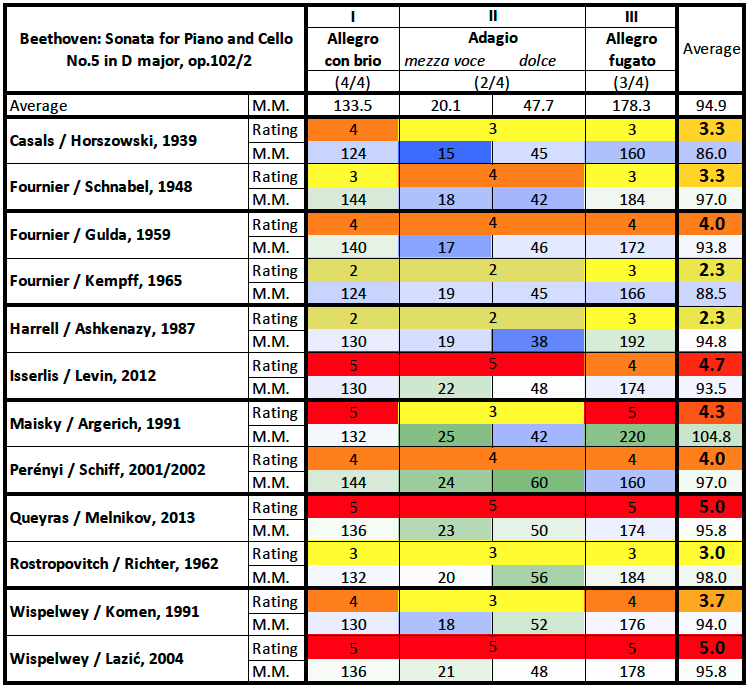Ludwig van Beethoven
Sonata for Piano and Cello in D major, op.102/2
Media Review / Comparison
2018-02-27 — Original posting
Table of Contents
- Introduction
- The Recordings
- Background, About the Composition
- The Interpretations, Overview
- The Interpretations in Detail
- Pablo Casals and Mieczysław Horszowski (1939)
- Pierre Fournier and Artur Schnabel (1948)
- Pierre Fournier and Friedrich Gulda (1959)
- Pierre Fournier and Wilhelm Kempff (1965)
- Lynn Harrell and Vladimir Ashkenazy (1987)
- Steven Isserlis and Robert Levin (2012)
- Mischa Maisky and Martha Argerich (1993)
- Miklós Perényi and András Schiff (2001/2002)
- Jean-Guihen Queyras and Alexander Melnikov (2013)
- Mstislav Rostropovich and Sviatoslav Richter (1962)
- Pieter Wispelwey and Paul Komen (1991)
- Pieter Wispelwey and Dejan Lazić (2004)
- Conclusions
- Addendum
Introduction
This is another note on the recordings of Beethoven’s sonatas for piano & cello in my music collection, about the Sonata in D major, op.102/2 — references to the CDs are given at the bottom of the respective section, or see the summary on the postings covering Beethoven’s Sonatas for Piano & Cello.
The Recordings
Below you find my comments on the recordings that I have for the Sonata for Piano and Cello in D major, op.102/2 (references to the recordings are given in each section). Here’s a short list of the recordings in this comparison, in alphabetic order (last name of the cellist):
- 1939: Pablo Casals & Mieczyslaw Horszowski
- 1948: Pierre Fournier & Artur Schnabel
- 1959: Pierre Fournier & Friedrich Gulda
- 1965: Pierre Fournier & Wilhelm Kempff
- 1987: Lynn Harrell & Vladimir Ashkenazy
- 2012: Steven Isserlis & Robert Levin
- 1993: Mischa Maisky & Martha Argerich
- 2001/2002: Miklós Perényi & András Schiff
- 2013: Jean-Guihen Queyras & Alexander Melnikov
- 1962: Mstislav Rostropovich & Sviatoslav Richter
- 1991: Pieter Wispelwey & Paul Komen
- 2004: Pieter Wispelwey & Dejan Lazić
Background, About the Composition
Ludwig van Beethoven (1770 – 1827) wrote his Sonata for Piano and Cello in D major, op.102/2 in 1815; he published both sonatas in op.102 two years later, with a dedication for Countess Anna-Maria Erdödy (1779 – 1837), for many years Beethoven’s admirer and patron.
The Movements
In comparison to its predecessor sonata, the Sonata for Piano and Cello in C major, op.102/1, Beethoven’s Sonata for Piano and Cello in D major, op.102/2 appears to follow a more conventional form scheme. It features three movements:
I. Allegro con brio (4/4)
The piano opens the movement with a motif that actually belongs to the second theme, and the cello follows up with another short introduction, before the actual theme sets in, in bar 8. Thereafter, the bulk of the movement is devoted to the second theme exclusively.
II. Adagio con molto sentimento d’affetto (2/4)
The tempo question is tricky here. The older interpretations simply ignore the 2/4 meter and play the Adagio in 4/8 time. This results in fairly endless melodies in the D minor part. However, as the piano part has note values down to hemidemisemiquavers, there seems to be no alternative, see also the table below.

In bar 25, the movements modulates to D major, the cello has a lovely, warm dolce cantilena, the left hand on the piano accompanies with a continuous flow of demisemiquavers:
At this point, the “tempo workaround” from the beginning no longer makes sense, everybody at least doubles the pace and now follows the 2/4 meter. When the movement returns to D minor, though (i.e., with the upbeat to bar 51), it is only logical to return to the initial tempo.
III. Allegro — Allegro fugato (3/4)
The final movement follows attacca, with a short 4-bar transition, where first the cello, then the piano present the initial part of the fugue theme, a simple ascending scale, starting at the fifth stage (A). Interestingly, this forms a Lydian scale—a medieval mode (church tonality) that Beethoven further explored in the central movement of his String Quartet in A minor, op.132. It’s essentially a major scale with a lowered seventh stage.
After the introduction, the final movement consists of a four-part fugue. Also this can be seen as a traditional (now baroque) feature—one which Beethoven again explores at length in several of his late compositions, such as the Piano Sonata No.29 in B♭ major, op.106 (“Hammerklavier“), and of course his Great Fugue in B♭ major, op.133, and several other works.
The Interpretations, Overview
In order to provide a rating overview, as well as an idea about tempo relations both within an interpretation, as well as between the two recordings, I have prepared the table below. The color coding for the tempo (blue = slower, green = faster) refers to the average between the recordings:
Note that the metronome rates are approximations—particularly because many performances involve strong rubato.
The Interpretations in Detail
All of the recordings below are part of complete sets, covering all Beethoven cello sonatas; most of them also include some or all of the variation sets, two include the sonata op.17, originally written for horn and piano.
Pablo Casals and Mieczysław Horszowski (1939)
Beethoven: The Sonatas for Cello & Piano; Variations WoO 46; Minuet in G, WoO 10/2
Pablo Casals & Mieczysław Horszowski
Otto Schulhof, Alfred Cortot
Allegro / The Great Performers, CDO 4005 (2 CDs, mono); © 2001
Booklet: 4 pp. english

For details / general information on the artists see my posting “Beethoven: Cello Sonata in A major, op.69“.
I. Allegro con brio
Duration: 7’20”
Horszowski begins rather straight & fluent (except for the slightly detached octave jumps with sf). All the more Casals’ big gesture and extreme rubato is standing out. In the following bars, the artists appear to take some time to find a common pace. In general, it appears difficult for the pianist to stay in line with Casals’ impulsive, expressive agogics. Casals ignores the pizzicato in bar 33—a minor point, really; in the recap section, he does observe the equivalent one in bar 107. The scope of Casals’ expression is astounding, from airy, whispered pp to percussive, expressive f passages with broad articulation, but never too legato. A beautiful tone is secondary here: what counts is the expression. Not a polished, modern recording, but still a very impressive interpretation, and a strong mind driving it!
II. Adagio con molto sentimento d’affetto
Duration: 9’19”
Casals’ tempo is extreme in its slowness. Yes, he does have the necessary calm and an almost infinite breath. It’s an endless melody, indeed, and impressive in its way—though one cannot perceive it as melody. Also, Hoszowski can’t quite match that calm—his intermittent solos are a tiny bit less calm, moving slightly faster.
The tempo change to the D major part is extreme (a factor of three!), requires almost a bar of accelerando, but then is close to the average for that segment. Is it the big change that makes me feel a very slight unrest in the D major part? Or is it just that the two artist aren’t exactly on the same line? In any case, I see Casals’ approach as an extreme—and an extreme challenge, too, very close to breaking / falling apart! If it wasn’t for Casals’ big patience (he seemed to know exactly how far he could go), his long-stretching melodic line (can’t call it a melody, really), I would definitely say that this is way too slow.
III. Allegro — Allegro fugato
Duration: 4’59”
The tempo is very moderate, almost clumsy—barely an Allegro. Yet, there are moments (e.g., bars 35/36) when the coordination is really marginal. Casals uses lively agogics / rubato, probably making it hard for Horszowski to follow in a “near live” situation.
| Duration: | 21’36” |
| Recommendation: | The first movement definitely is the best one here. Yet, this certainly remains a most valuable historic document, despite some “rough edges”. |
| Rating: | 3.3 (4 / 3 / 3) |
Pierre Fournier and Artur Schnabel (1948)
Beethoven: The Sonatas for Cello & Piano; Schubert: 6 Moments Musicaux op.94, D.780
Pierre Fournier & Artur Schnabel
Andromeda, ANDRCD 5108 (2 CDs, mono); ℗ 2007
Booklet: 4 pp. (track listing only)

For details / general information on the artists see my posting “Beethoven: Cello Sonata in A major, op.69“.
I. Allegro con brio
Duration: 6’06”
Completely different from Casals / Horszowski! The latter adjusts to the cellist. However, Schnabel, as a musical mind, is at least as strong as the cellist—and he follows his musical concept irrespective of losses and technical limitations. He storms into the opening bars at a fast pace, such the the semiquavers turn into mere acciaccaturas. There is no separation between these and the sforzati on the punctuated half notes. That does not imply that Fournier is simply run over: right from the beginning, he presents is big, singing tone. From a point-of-view of recording technique, the cello dominates, but the two artists follow the same line, with Fournier almost matching Schnabel’s impulsive agogics.
From today’s perspective, I prefer Casals / Horszowski, as this seems rather pushed—pushed to the extreme, at times: fast articulative details occasionally fall through the cracks. But it still is an impressive, strong interpretation!
II. Adagio con molto sentimento d’affetto
Duration: 10’04”
The D minor part is a tad faster than Casals’, and Fournier uses a much denser, singing tone. What he doesn’t quite have in calm and stretch, he makes up with his singing tone, the long, dynamic arches. It’s very nice in the moment, but still doesn’t “hold together” the structure.
The D major part is beautiful, intensely singing, and much more of a common / joint approach. The tempo transitions (not quite so extreme) are almost instantaneous (one crotchet per transition), particularly the return to the slow pace.
From the cello point-of-view, the D minor parts are a tad too slow, but I suspect Schnabel knew what he aimed for. I should add that there isn’t a moment of impatience with the two musicians, especially towards the end, when the tension gets almost unbearable!
III. Allegro — Allegro fugato
Duration: 4’18”
Less percussive and rough on the cello than Casals. On the other hand, the cello tone in the descant register is not captured very well. At a faster tempo, the recording is also less transparent. Still, Schabel’s playing is clear, even though he often appears to leave the lead role to the cellist. And the coordination is much better than with Casals’ recording.
| Duration: | 20’26” |
| Recommendation: | Another historic landmark! |
| Rating: | 3.3 (3 / 4 / 3) |
Pierre Fournier and Friedrich Gulda (1959)
Beethoven: The Sonatas for Cello & Piano; Variations WoO 45, 46, op.66
Pierre Fournier & Friedrich Gulda
IDG 00289 477 6266 (2 CDs, stereo); ℗ 1960 / © 2006
Booklet: 24 pp. e/d/f

For details / general information on the artists see my posting “Beethoven: Cello Sonata in A major, op.69“.
I. Allegro con brio
Duration: 6’29”
Of course, the sound in this stereo recording is much better, especially in terms of balance between piano and cello, transparency, overall sound. Gulda is as strong as an artistic mind as Schnabel—but less extreme. Fournier is absolutely in line with the piano, though far less dominant, his sound, albeit singing, using the same articulation, etc., appears somewhat muffled, in comparison. Clearly, the most impressive part of the interpretation is with the pianist: always very clear in the articulation, detailed in rhythm and dynamics, dominant in agogics and overall presence: excellent! Clearly: a sonata for piano and cello, not the other way around!
II. Adagio con molto sentimento d’affetto
Duration: 9’15”
Hmmm… already the first interval on the cello is a prominent portamento—not quite to my taste. It’s very slow, too, and Gulda keeps his part very dark, somber, largely leaving the singing to Fournier. Except for short motifs, where the piano briefly takes the lead or sing with the cello.
The D major part is marvelous: here, the roles are inverted, in that Gulda clearly takes over the melody. Fournier assumes the secondary role, occasionally forming a duet with Gulda’s right hand. Serene, masterful!
The tempo transitions are immediate. The serene middle part is spoiling the listener: the second D minor part occasionally feels somewhat static.
III. Allegro — Allegro fugato
Duration: 4’32”
Friedrich Gulda at his best, with his clear, transparent playing and articulation, the poignant accents, the differentiated dynamics—for every single voice, individually! In fact, it sometimes appears difficult for Fournier to maintain his presence & profile, given Gulda’s masterful, sometimes somewhat dominant performance.
| Duration: | 20’15” |
| Recommendation: | Beyond any doubt Fournier’s best recording, beating many of the more recent recordings: a really strong performance, likely one of the best in the past century! |
| Rating: | 4.0 (4 / 4 / 4) |
Pierre Fournier and Wilhelm Kempff (1965)
Beethoven: The Sonatas for Cello & Piano; Variations WoO 45, 46, op.66
Pierre Fournier & Wilhelm Kempff
DG 453 013-2 (2 CDs, stereo); ℗ / © 1966
Booklet: 28 pp. e/d/f/i/sp

For details / general information on the artists see my posting “Beethoven: Cello Sonata in A major, op.69“.
I. Allegro con brio
Duration: 6’38”
Six years later, the recording technique has moved further on: the balance is better, the two artists are partners on a par. That’s the primary positive thing to mention here. Fournier’s tone is still as beautiful and singing as in the older recordings. However, in terms of technical and rhythmic precision, poignancy and detail (dynamics and articulation), Kempff is nowhere near Gulda, nor does he exhibit an interpretative concept nearly as strong as Schnabel or Gulda. The playing is occasionally a tad defensive in the tempo, contrasting with more aggressive, forward-moving segments. The cello tone seems a tad muffled, occasionally as if played behind a curtain. On the cello, staccato notes are too broad, almost tenuto / portato. Also, Fournier tends to use legato with lighter, softer parts of a phrase.
II. Adagio con molto sentimento d’affetto
Duration: 8’49”
The initial portamento is almost identical to that of the previous recording with Gulda. The D minor part is a tad faster than the older recordings. Yet, it seems too slow, as it lacks the calm, the patience, especially in the piano part. Also Fournier is no longer quite able to sustain the long dynamic arches with the calm that he used to exhibit.
That also—even more so—applies to the D major part. Quite obviously, this movement—albeit technically not so challenging—is extremely tough to master!
III. Allegro — Allegro fugato
Duration: 4’46”
Kempff’s playing is clear, though not nearly as poignant, transparent and differentiated as Gulda’s. Sometimes, the pianos even turns out a soft side, then again breaks out into almost coarse eruptions. The second fugue theme is very, almost extremely mellow & gentle at its introduction. Overall, it’s the best of the movements in this recording.
| Duration: | 20’13” |
| Recommendation: | If you want a recording with Fournier, go for the one with Friedrich Gulda! I just fail to understand why DG did not adopt the recording with Gulda into their 1970 Beethoven anniversary edition! |
| Rating: | 2.3 (2 / 2 / 3) |
Lynn Harrell and Vladimir Ashkenazy (1987)
Beethoven: The Sonatas for Cello & Piano
Lynn Harrell & Vladimir Ashkenazy
Decca / London 417 628-2 (2 CDs, stereo); ℗ / © 1987
Booklet: 39 pp. e/f/d

For details / general information on the artists see my posting “Beethoven: Cello Sonata in A major, op.69“.
I. Allegro con brio
Duration: 6’35”
A good, solid interpretation, good partnership. Sadly, the cello tone is really very much muffled, dull, and badly defined: in passages such as bars 14/15, one hears the cello playing, but it seems impossible to tell which tones Harrell plays. Often staccato notes consist of mostly bow noise, with very little defined sound / pitch. And the cello articulation is often unclear, although intermittently, the instrument does exhibit a nice, singing tone, at least in the middle and high registers. Some of this may be attributable to inadequate recording technique / setup.
II. Adagio con molto sentimento d’affetto
Duration: 9’42”
Largely calm (adagio), yes, but also often lacking tension. The tempo is not as extremely slow as Casals’: about the same as Fournier / Kempff in the D minor part, but Harrell’s nervous and ubiquitous vibrato is distracting, disturbs the calm atmosphere.
The D major part is the fastest (the least slow) of all.; the comparison with the others, plus the vibrato, makes me feel a slight unrest. I’m not convinced of this performance—it’s not compelling. Also, the end doesn’t seem to build up tension towards the last movement, rather just quietly fades away.
III. Allegro — Allegro fugato
Duration: 4’11”
Also here, the cello often sounds muffled (especially in the lower registers), and it often appears to hide behind the piano. That’s likely due to the recording technique—though, the tone of the instrument is probably very (unfavorably) dark in the lower register. The tempo is very fluent, and Ashkenazy’s clear, fairly poignant playing makes this the best movement in this recording.
| Duration: | 20’26” |
| Recommendation: | The last movement is mostly OK (apart from the recording technique, maybe the instrument’s dull sound?), but otherwise, this can’t compete in the top league. |
| Rating: | 2.3 (2 / 2 / 3) |
Steven Isserlis and Robert Levin (2012)
Beethoven: The Sonatas for Cello & Piano, incl. op.17; Variations WoO 45, 46, op.66
Steven Isserlis & Robert Levin
hyperion CDA67981/2 (2 CDs, stereo); ℗ / © 2014
Booklet: 24 pp. e/f/d

This is a recent recording, with Steven Isserlis (*1958), accompanied by Robert Levin (*1947). Isserlis plays a cello by Stradivarius, “Marquis de Corberon”, from 1726, and a Tourte bow. Levin plays a fortepiano by Paul McNulty — a replica after an instrument by Walter & Sohn from around 1805.
I. Allegro con brio
Duration: 6’43”
I don’t need to “sing the praise of the Walter fortepiano (replica)”—I have already done that extensively with the other sonatas. But beyond that, Steven Isserlis’ Strad sound is just mind-boggling! OK, this may largely be due to a microphone placement close to the instrument, but still… In addition, the dark full bass sound of the cello contrasts nicely with the singing, bright bass register of the fortepiano. This way, there is never a danger of the cello “hiding in the pianist’s left hand” (as with some of the traditional recordings)—transparency and balance in sound are really natural here!
Besides Steven Isserlis’ “speaking” dynamics & phrasing, I particularly liked the play with agogics, the subtle rubato that goes along with the phrasing arches. Like Wispelwey, Isserlis uses vibrato sparingly, in a “targeted” fashion. His articulation is quite percussive (approaching Casals?) and very expressive.
One little side-note: Robert Levin exploits the capacities of the Walter fortepiano to its very limits. In fact, I suspect that for the late cello sonatas a Graf fortepiano from around 1815 (when Beethoven composed these sonatas) might have been more adequate.
II. Adagio con molto sentimento d’affetto
Duration: 8’12”
Interestingly the tempo in both parts (i.e., also the tempo relation) in this performance is virtually identical to the one with Wispelwey / Lazić. The same can be said about the general approach, certainly in the first 8 bars. Certainly, I can’t ay which of the cello parts I prefer, throughout the movement: both are absolutely compelling, even though there are definitely differences in the details. I admire Isserlis’ beautiful, big dynamic arches—and his unpretentious attitude in this movement.
Sure, a key difference is with the fortepiano. Levin does use the moderator, particularly in the soft segments in the D minor part, allowing Isserlis to use real soft, subtle pp playing: wonderful! And even with moderator, the instrument retains most of its singing tone / quality. The only, very minor quibble / disadvantage of the fortepiano: the modern concert grand appears to allow for more poignant articulation in bars 58ff., judging from Dejan Lazić’s playing in Pieter Wispelwey’s 2004 recording.
III. Allegro — Allegro fugato
Duration: 4’34”
I can’t add much to the comments already made—this remains an excellent recording. the only, minor quibble with this is that in comparison to the brilliant, singing, bright sound of the Walter fortepiano, Steven Isserlis’ Strad sometimes sound rather dark, if not sometimes grumbling in the low register.
| Duration: | 19’27” |
| Recommendation: | My first choice for a recording with fortepiano, and also this is strongly recommended. |
| Rating: | 4.7 (5 / 5 / 4) |
Mischa Maisky and Martha Argerich (1993)
Beethoven: The Sonatas for Cello & Piano; Variations WoO 45, 46, op.66
Mischa Maisky & Martha Argerich
DG 453 748-2 (2 CDs, stereo); ℗ 1991/93 / © 1997
Booklet: 46 pp. e/d/f

For details / general information on the artists see my posting “Beethoven: Cello Sonata op.5/1”.
I. Allegro con brio
Duration: 6’33”
Almost like Schnabel, Argerich is storming into the semiquavers—yet, she never goes beyond the point where she can’t keep the articulation clean and clear. Also similar to Fournier / Schnabel, Maisky at first appears to enter more carefully than the piano, keeping tone and articulation soft in the dolce segment. But once he reaches f (bar 13), it is clear that the two artists play out of one spirit, one mind: very impulsive, expressive and detailed in dynamics and articulation, so vivid and rich, full of life in agogics. And Martha Argerich is ever so alert, present—at her best, enthralling! Misha Maisky is excellent, in line with the piano, of course, though maybe not always quite as poignant as the pianist.
II. Adagio con molto sentimento d’affetto
Duration: 8’34”
This is the fastest D minor part of all (along with Perényi / Schiff and Queyras / Melnikov). Of course, at ♩=25, it still does not feel like 2/4 time. That’s not the problem, though—but what I object to is, that Maisky makes every single note a “belly note” (swelling in the middle), at least initially, and when that theme returns. Together with the fairly laden vibrato, I find it kind of hard to enjoy this.
The D major part is faster, but not even doubling the tempo from the D minor part, this means that there is less differentiation between the D minor and the D major parts (apart from the tonality, of course). Martha Argerich can’t play out her strengths in this movement.
III. Allegro — Allegro fugato
Duration: 3’52”
Much faster than anybody else, extremely virtuosic / agile on both parts: Argerich at her best again (that’s music that really suits her!)! And Misha Maisky can play out his virtuosic power, does not get a chance to dwell in excesses of vibrato. Excellent!
| Duration: | 18’59” |
| Recommendation: | Very good, excellent in the fast movement, less so in the Adagio. |
| Rating: | 4.3 (5 / 3 / 5) |
Miklós Perényi and András Schiff (2001/2002)
Beethoven: The Sonatas for Cello & Piano, incl. op.17; Variations WoO 45, 46, op.66
Miklós Perényi & András Schiff
ECM New Series 1819/20 (2 CDs, stereo); ℗ / © 2004
Booklet: 28 pp. d/e

For details / general information on the artists see my posting “Beethoven: Cello Sonata in A major, op.69“.
I. Allegro con brio
Duration: 6’01”
The artists seem to focus on the allegro con brio tempo annotation, taking a rather fast tempo—the fastest in this comparison. Articulation and dynamics are very detailed, careful, thoughtful, considerate, both on piano and cello. I particularly like Schiff’s diligent articulation, his differentiated dynamics, the transparency, the phrasing. That’s all excellent—but still, the performance (to me) feels too much driven, not leaving enough time for some (fast, short-scale) detail, therefore also lacking time for some more agogics, not leaving “room to breathe”. In fact, I feel a bit breathless after this movement.
II. Adagio con molto sentimento d’affetto
Duration: 6’34”
About the same tempo as Maisky / Argerich, but Perényi uses much calmer articulation and dynamics. The artists don’t slow down, rather get more fluent over the D minor section, making up for the fastest performance overall. and Schiff manages amazingly well to make the listener feel the 2/4 meter. This goes along with a slight, overall unrest, a “pull” that may be seen as not in agreement with the Adagio annotation. I don’t mean to blame the artists, though: that’s a conflict that is inherent with Beethoven’s meter / tempo annotation.
The D major part is the fastest of all, faster than Rostropovich / Richter even. It’s very nicely singing, a simple, beautiful cantilena. Perényi plays with little vibrato and dynamics, emphasizing the long melody lines. However, it definitely does feel like an Andante, if not Andante con moto even. It sounds and feels very nice—but does it fit the Adagio con molto sentimento d’affetto annotation?
III. Allegro — Allegro fugato
Duration: 4’42”
Very careful, excellent articulation, dynamics, phrasing, differentiation, good sound. However, the tempo feels a bit on the slow side, the performance somewhat academic, overall, almost schematic at times.
| Duration: | 17’16” |
| Recommendation: | A good, solid, reliable performance without real flaws. It does certainly not stretch the limits, feels rather tames, if not at times academic. |
| Rating: | 4.0 (4 / 4 / 4) |
Jean-Guihen Queyras and Alexander Melnikov (2013)
Beethoven: The Sonatas for Cello & Piano; Variations WoO 45, 46, op.66
Jean-Guihen Queyras & Alexander Melnikov
Harmonia mundi HMC 902183.84 (2 CDs, stereo); ℗ 2014
Booklet: 20 pp. f/e/d

For details / general information on the artists see my posting “Beethoven: Cello Sonata in A major, op.69“. Queyras plays a cello by Gioffredo Cappa from 1696, Melnikov plays a modern concert grand.
I. Allegro con brio
Duration: 6’24”
Queyras is absolutely outstanding in his articulation, dynamics, agogics, the careful phrasing. He is meticulously following Beethoven’s dynamics and articulation—yet never feels even a tiny bit academic or dry! His tone is beautiful, the intonation flawless, even though he is largely playing without vibrato (which I really like!). Alexander Melnikov is just as careful, uses the full dynamic scope, is always very clear in the articulation, technically absolutely flawless, perfect—yet, he never inappropriately plays himself into the foreground. The coordination is just as perfect, of course—a performance and interpretation out of one single spirit / mind: it’s hard to imagine anything better (on modern instruments, at least)!
II. Adagio con molto sentimento d’affetto
Duration: 7’31”
The tempo is fairly fluent (about the same as with Maisky / Argerich and Perényi / Schiff). For the first 8 bars, Queyras keeps the tone entirely flat, emotionless. In addition, the artists treat each pair of bars (each pair ending in a general rest) as stand-alone phrase. With this, each of the phrases feels like a short melody fragment, almost closed in itself. Initially, this may feel a bit short-winded and contradicting the con molto sentimento d’affetto. However, with the following bars, it turns out that this only served as introduction, and/os as presentation of the theme or the backbone of the music that follows. As soon as the piano takes over the cantilena, the melody, the singing and the emotions start evolving.
Even more so, in the D major part, the cantilena is blooming marvelously. And now, there is also more tone and a carefully crafted vibrato. Yet, the emotions are not overflowing, nothing is ever overblown. The tempo is almost exactly doubled from the D minor part. This may be part of the explanation why in this performance, the tempo change to the D major part (and later again back to the second D minor part) is almost inconspicuous, i.e., entirely natural: one essentially does not feel the change in pace, but merely a different atmosphere. Absolutely masterful!
III. Allegro — Allegro fugato
Duration: 4’37”
Not much faster than Perényi / Schiff, yet, there is no much more life, differentiation & detail in every voice, every melody line, excellent transparency, and a clear overall dramaturgy, forming large arches that the listener can follow—simply excellent!
| Duration: | 18’31” |
| Recommendation: | My clear favorite (with modern piano), along with Wispelwey / Lazić: highly recommended! |
| Rating: | 5.0 (5 / 5 / 5) |
Mstislav Rostropovich and Sviatoslav Richter (1962)
Beethoven: The Sonatas for Cello & Piano
Mstislav Rostropovich & Sviatoslav Richter
Philips 412 256-2 (2 CDs, stereo); ℗ 1963
Booklet: 11 pp. e/d/f

For details / general information on the artists see my posting “Beethoven: Cello Sonata in A major, op.69“.
I. Allegro con brio
Duration: 6’22”
As expected: a solid performance, technically flawless, of course. Sadly, the recording technique is worse than with Fournier / Gulda. The two instruments are spatially separated, but each sounds one-dimensional, like a combination of two mono recordings (one microphone per instrument, obviously). In terms of articulative detail, agogics, dynamics, etc., time has moved on, the performance can hardly compete with the top class of newer recordings.
II. Adagio con molto sentimento d’affetto
Duration: 7’31”
At least in soft, retained parts, Rostropovich plays without any vibrato, though, of course, in the intense parts, he does vibrate. Among the older (pre-1990) recordings, this the most fluent one, and in the D major part, it’s among the fastest of all. The D minor parts are good, though not standing out from the average of the recordings in this comparison. The D major segment may feel somewhat restless (in comparison), but is kept simple, flowing, really like a Lied, with really nice cantilenas. In that approach, it is quite impressive, attractive, really a love song of sorts.
III. Allegro — Allegro fugato
Duration: 4’03”
Technically flawless, of course: to masters of their instrument(s) at work! But the recording technique has limitations, see above. And in terms of differentiation in articulation, agogics, dynamics, etc. newer recordings beat this.
| Duration: | 17’56” |
| Recommendation: | Meanwhile, this, too, has become a historic document, featuring two instrumentalists with top reputation, not just as artists, but also (particularly in the case or Rostropovich) for their humanitarian and political positions in the times of the Cold War. Still, I would not recommend this as the only recording in a collection. AS historic recording, besides Casals, I would rather recommend Fournier / Gulda. |
| Rating: | 3.0 (3 / 3 / 3) |
Pieter Wispelwey and Paul Komen (1991)
Beethoven: The Sonatas for Cello & Piano
Channel Classics CCS3592 (2 CDs, stereo); ℗ / © 1992
Booklet: 20 pp. e/nl/d/f

Pieter Wispelwey (*1962) recorded the Beethoven cello sonatas twice; this is the earlier recording, covering the sonatas only (not the variations or op.17), with Paul Komen playing a historic Broadwood fortepiano from 1823 (the same instrument model that Beethoven received from Broadwood in 1818 as a gift, on behalf of Muzio Clementi). Wispelwey plays a cello by Barak Norman from 1710.
I. Allegro con brio
Duration: 7’05”
13 years before the later recording below, Wispelwey was already fairly close to his later interpretation, in terms of vibrato, articulation, etc.; the big difference is in the historic Broadwood fortepiano. As I already mentioned with the earlier sonatas, this can’t really compete with the Viennese instruments of that time, in that if doesn’t offer the same amount of differentiation and subtlety, the singing tone, the richness in colors. It may have vastly more volume (though I doubt even that), but it sounds somewhat rough, coarse. And the mutes are (deliberately) short, so the dampening is incomplete, to a degree where rests are often (if not mostly) filled with residual resonances (and these aren’t always harmonics!). Some of the latter may also be caused by occasional over-use of the sustain pedal?
It’s very interesting, still—but it can’t compete with more recent historically informed recordings, see Isserlis / Levin. It is an open question how Broadwoods really sounded in the early 19th century.
II. Adagio con molto sentimento d’affetto
Duration: 9’45”
I’m listening to this after the recording with Dejan Lazić. In comparison to the newer recording, the general approach is obviously similar, even though the D minor part is slower (in line with the traditional performances), the D minor part, in contrast, is distinctly faster. That stronger contrast necessitates a gradual accelerando, which I find less compelling (in comparison to the “natural” doubling of the tempo).
Here, the Broadwood instrument is even more at a disadvantage, with its relatively rough tone. It is not obvious wether (and how much) the moderator was used to soften the tone. The instrument also presumably has a “bassoon stop”, but I don’t think it would be advisable to use that. Finally, also the ending is less compelling than the one in the 2004 recording. In comparison, it lacks tension, doesn’t raise the same amount of expectation.
III. Allegro — Allegro fugato
Duration: 4’39”
The Broadwood may have its rough edges—at least, here, it can play out its strengths, with its richness and differentiation in colors, from the noisy bass to the distinctly different middle and descant registers. It’s not subtle, for sure, but still very much suited for this type of music & texture.
| Duration: | 21’28” |
| Recommendation: | If you want to hear a Broadwood piano in chamber music, with its pros and cons: here’s an exemplary recording! Overall, as stated, I don’t think the Broadwood is the right choice here, and if you are interested in a recording with fortepiano, I’d rather recommend the recording with Isserlis & Levin. |
| Rating: | 3.7 (4 / 3 / 4) |
Pieter Wispelwey and Dejan Lazić (2004)
Beethoven: The Sonatas for Cello & Piano; Variations WoO 45, 46, op.66
Pieter Wispelwey and Dejan Lazić
Channel Classics CCS SA 22605 (2 CDs, stereo); ℗ / © 2005
Booklet: 20 pp. e/nl/f/d

In his more recent recording from 2004, Pieter Wispelwey (*1962) is playing a cello by Guadagnini. He opted to partner with a modern piano, played by Dejan Lazić (*1977).
I. Allegro con brio
Duration: 6’52”
Overall, this recording is very close to Melnikov / Queyras: Wispelwey uses a little vibrato, bus always selectively, consciously (e.g., on long notes with a crescendo). The performance feels a tad more fluent, a little more mellow and careful, maybe a bit more harmonious, round. It’s perhaps not always quite as “outspoken” and direct in articulation and dynamics. But just as good, overall—hard to decide between the two! Recording technique: excellent! I like how on the last note one can hear the resonance of the empty cello strings fade away after Wispelwey lifts the bow!
II. Adagio con molto sentimento d’affetto
Duration: 8’19”
Initially, the approach here is close to that of Queyras / Melnikov: a relatively fluent tempo, four short two-bar phrases, though with a little, careful vibrato, a little more tone & emotion. Thereafter, the emotions grow, the dynamics turn expansive. Though, in the D minor part, the atmosphere remains earnest, somewhat restrained.
And again, in the D major part, the serene, lucid melody is allowed to flourish, the two musicians form a very harmonious duet, singing, an eloquent discourse with occasional outbreaks of emotion. In comparison to Queyras, the D minor and D minor parts are kept more apart, don’t seamlessly flow into each other. Lazić’s articulation in the segment at bars 58ff. is masterful, certainly the clearest and most poignant, most pronounced of all recordings with modern piano. Excellent also the last bars, which are not just fading away, but building expectation, tension towards the Allegro, in an exemplary fashion!
III. Allegro — Allegro fugato
Duration: 4’26”
The four Allegro bars carry forward the high tension, the load of expectation from the prior ending: a good vibrant tempo already in these four bars! And once more, I can’t tell whether this or Queyras / Melnikov come out at the very top. Certainly not identical—maybe this recording is a tad more harmonious, while Queyras / Melnikov maybe have a slight edge in poignancy and clarity?
| Duration: | 19’36” |
| Recommendation: | My clear favorite (with modern piano), along with Queyras / Melnikov: highly recommended! |
| Rating: | 5.0 (5 / 5 / 5) |
Conclusions
No surprises with this sonata—the results are very much in line with the ones of the other cello sonatas:
- Historic landmarks: Casals / Horszowski, of course, but in terms of listening pleasure and experience, rather Fournier / Gulda.
- Modern piano: Queyras / Melnikov and Wispelwey / Lazić—with Maisky / Argerich as strong contenders, at least in some movements.
- Historic instrument / fortepiano: clearly Isserlis / Levin
I should add, though, that this is is a judgement of CD recordings only.
Concert experiences may be (or have been) different, because
- they don’t suffer from the limitations of (older) recording technique
- on the other hand, more often than not, to my dismay, I have witnessed pianists playing on a modern concert grand with fully open lid, which almost inevitably causes serious balance issues. Actually, this is pretty much the (dreadful) norm. Here, a fortepiano—preferably not in a huge venue, of course—has definite advantages. Sadly, performances with fortepiano still are rare exceptions. Though, there is hope that they are now becoming more and more popular. This point, however, is not taken into account in the above comparison.
Addendum
I’m using pocket scores (Lea Pocket Sores, Kalmus or Eulenburg) to follow this music while listening. —Find pocket score on amazon.com (#ad) —






























